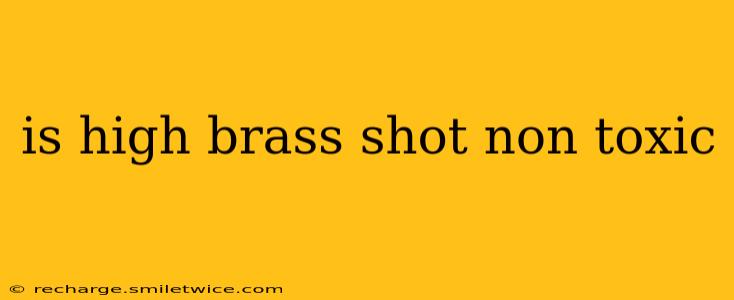Is High Brass Shot Non-Toxic? Understanding Shot Toxicity and Environmental Impact
The question of whether high brass shot is non-toxic is complex and depends on what you mean by "non-toxic" and the specific composition of the shot. Let's break down the different aspects.
Understanding "High Brass" Shot:
The term "high brass" typically refers to the shell casing, not the shot itself. High brass shells are generally associated with higher-velocity loads, but the shot inside could be made of various materials. The type of shot used significantly impacts its toxicity.
Types of Shot and Their Toxicity:
-
Lead Shot: Traditionally, most shotgun ammunition used lead shot. Lead is highly toxic to wildlife, especially waterfowl, and can bioaccumulate in the food chain. Lead poisoning is a significant concern for many bird species. Lead shot is NOT non-toxic.
-
Steel Shot: Steel shot is a common non-toxic alternative to lead. It's less dense than lead, requiring adjustments in choke and load to achieve comparable patterns. Steel shot is generally considered environmentally friendly, though it can still cause damage to certain gun barrels if used incorrectly. Steel shot is generally considered non-toxic.
-
Other Non-Toxic Shot: Beyond steel, other materials are used, including bismuth, tungsten-iron, and various alloys. These options are generally considered non-toxic but are often more expensive than steel shot.
Therefore, a "high brass" shell can contain either toxic (lead) or non-toxic (steel, bismuth, etc.) shot. The shell casing itself is not the determining factor in toxicity.
What are the environmental concerns surrounding shotgun shot?
The primary environmental concern surrounding shotgun shot is the toxicity of lead. Lead shot ingested by birds and other wildlife can cause lead poisoning, leading to death or debilitating health effects. This has prompted numerous regulations and restrictions on the use of lead shot in many areas.
What are the alternatives to lead shot?
Several non-toxic alternatives to lead shot are available, including steel, bismuth, tungsten-iron, and various other alloys. The choice of alternative depends on factors such as cost, intended use, and the regulations in place.
How do I know if my high brass shot is non-toxic?
To know for sure whether your high brass shot is non-toxic, carefully check the shell's packaging. The type of shot (lead, steel, etc.) will usually be clearly stated.
Are there any regulations regarding the use of lead shot?
Yes, many jurisdictions have implemented regulations or bans on the use of lead shot, particularly in areas frequented by waterfowl. These regulations vary widely, so it's essential to check your local hunting regulations before using any shotgun ammunition.
In summary, the "high brass" designation alone doesn't indicate whether the shot is non-toxic. The material of the shot itself is the critical factor, with lead being toxic and alternatives like steel generally considered non-toxic. Always check the packaging to identify the shot material and be aware of local regulations regarding its use.
